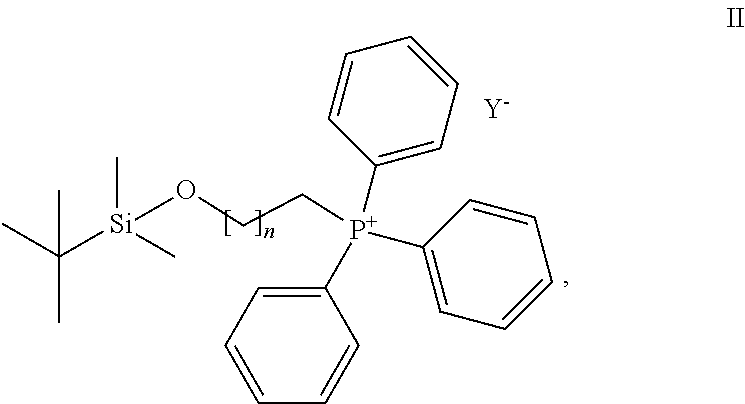Compounds for treatment of senescence-related disorders
- Summary
- Abstract
- Description
- Claims
- Application Information
AI Technical Summary
Benefits of technology
Problems solved by technology
Method used
Image
Examples
example 1
[0035](9-((tert-butyldimethylsilyl)oxy)nonyl)triphenylphosphonium bromide (634 mg, 1.057 mmol) was dissolved in dry tetrahydrofuran (THF) (6 ml), covered with argon atmosphere and cooled down to −78° C. Butyl lithium (1.2 ml, 0.9 M solution in THF) was slowly added dropwise to the reaction mixture under argon atmosphere. The solution was allowed to warm up to 0° C., colour was changed to dark red, cooled to −78° C. again and aldehyde of the formula Ma (160 mg, 0.430 mmol) dissolved in dry THF (3 ml) was added dropwise. Then the reaction mixture was allowed to warm up to the laboratory temperature and stirred for 16 hours under argon atmosphere. Progress of the reaction was monitored with thin layer chromatography (TLC) in the mixture of chloroform-methanol (10:1). Then saturated solution of ammonium chloride and water was added to the reaction mixture and extracted with ethyl acetate. The ethyl acetate layer was washed with brine and dried over magnesium sulphate. The solution was f...
example 2
Method A
[0041]Silylated derivative of the formula 4 (147 mg, 2.240 mmol) was dissolved in THF (5 ml), then covered with argon atmosphere and tetrabutylammonium fluoride (TBAF) (260 μl, 1M solution in THF) was added dropwise at a temperature of 0° C. under the stiffing. Then the reaction mixture was allowed to warm up to laboratory temperature and stirred for another 6 hours. Progress of the reaction was monitored with TLC in the mixture of chloroform-methanol (10:1). Then water was added and the mixture was extracted with ethyl acetate. The ethyl acetate layer was washed with saturated solution of soda and brine and dried over magnesium sulphate. The desiccant was filtered and the solution was concentrated under reduced pressure. The concentrate was purified with the column chromatography on silica gel in the system chloroform / methanol (gradient 0 to 10% of methanol) to yield 115 mg (96% yield) of the required alkenol of the formula 5.
Method B
[0042]Triphenylphosphine (161.5 g, 615.8...
example 3
[0047]Alkenol derivative of the formula 5 (115 mg, 0.231 mmol) was dissolved in absolute ethanol (6 ml) and covered with argon atmosphere. 10% Pd / C (10 mg) was added to the mixture and the flask with reaction suspension was evacuated and covered with hydrogen atmosphere repeatedly for several times. Then the reaction mixture was stirred at the laboratory temperature under the hydrogen atmosphere for 24 hours. Progress of the reaction was monitored with TLC in the mixture of chloroform-methanol (10:1). The mixture was filtered through a layer of Celite and washed several times with ethanol. Ethanol was evaporated to yield 101 mg (87% yield) of the required alcohol of the formula 6, which is used without any further purification for the next step of the synthesis.
[0048]1H NMR (500 MHz, CD3OD) δ 7.40-7.01 (m, 10H), 6.85 (d, J=8.1, 2H), 6.68 (d, J=8.1, 2H), 4.20 (s, 2H), 3.55 (t, J=6.4, 2H), 3.46 (s, 2H), 2.89 (s, 6H), 2.42 (t, J=7.8, 2H), 1.57-1.48 (m, 2H), 1.38-1.11 (m, 12H). ESI MS: ...
PUM
| Property | Measurement | Unit |
|---|---|---|
| Volume | aaaaa | aaaaa |
| Volume | aaaaa | aaaaa |
| Volume | aaaaa | aaaaa |
Abstract
Description
Claims
Application Information
 Login to View More
Login to View More - R&D
- Intellectual Property
- Life Sciences
- Materials
- Tech Scout
- Unparalleled Data Quality
- Higher Quality Content
- 60% Fewer Hallucinations
Browse by: Latest US Patents, China's latest patents, Technical Efficacy Thesaurus, Application Domain, Technology Topic, Popular Technical Reports.
© 2025 PatSnap. All rights reserved.Legal|Privacy policy|Modern Slavery Act Transparency Statement|Sitemap|About US| Contact US: help@patsnap.com



